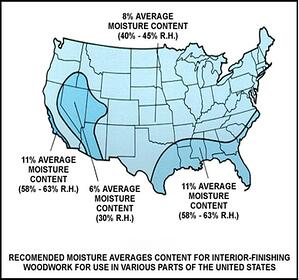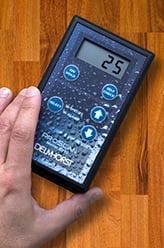For both lumber manufacturers/distributors and the contractors who actually install wood flooring, acclimation is an important consideration. With improperly acclimated wood, issues such as deformities in the wood can occur over time, leading to callbacks and lost business. To avoid this, lumber manufacturers and flooring installers not only acclimate the wood they’re working with, but check that acclimation with a wood moisture meter.
How do lumber manufacturers and wood flooring installers acclimate lumber, and how do they use moisture meters for wood to check said acclimation? To answer these questions, here are a few tips for acclimating flooring wood and checking the acclimation.
Tip #1: Acclimating Wood for a Specific Region
Wood is a hygroscopic material, meaning that it will absorb or bleed moisture until it reaches equilibrium with its surroundings. When wood is being prepared for shipment to a specific region of the country, it needs to be acclimated to the conditions of that region. Why? Because, different parts of the country have different levels of moisture in the air.
 What are these moisture levels for the different parts of the country? In the map here, you can see that while the majority of the continental U.S. averages roughly 40% to 46% relative humidity, requiring lumber to have 8% average moisture content for optimal acclimation, some areas have far less relative humidity (30% RH). Along coastal areas, RH levels tend to be much higher, so you would actually want to have a little more moisture content in wood being prepared for areas such as Florida (around 11% MC).
What are these moisture levels for the different parts of the country? In the map here, you can see that while the majority of the continental U.S. averages roughly 40% to 46% relative humidity, requiring lumber to have 8% average moisture content for optimal acclimation, some areas have far less relative humidity (30% RH). Along coastal areas, RH levels tend to be much higher, so you would actually want to have a little more moisture content in wood being prepared for areas such as Florida (around 11% MC).
The reason for acclimating wood for a specific region is simple. If, after arriving at the destination, wood has too much or too little moisture for the relative humidity in the area, it will soak up or shed moisture until reaches equilibrium. If too much moisture is lost or gained too quickly, wood can become deformed, experiencing severe buckling or warping as a result.
Tip #2: Where to Store Lumber
This tip is aimed more at the contractors who will be installing lumber than the producers of lumber.
As stated in the National Wood Flooring Association’s guidelines for installing wood flooring, it is important that you, “Do not store wood flooring at the jobsite under uncontrolled climate conditions.” For example, a temporary shed or open-air pallet on the site is not the best place to store lumber.
Instead, the NWFA recommends that you check with the lumber manufacturer to see whether or not the wood flooring needs to be acclimated before installation. If it does need acclimation, the wood is best acclimated inside of the building it will be installed in IF:
-
The building is enclosed.
-
The building is at the normal operating conditions for temperature and humidity.
-
Installed heating and air-conditioning systems are in operation.
Tip #3 How Long to Acclimate Flooring Wood
On the jobsite, flooring lumber should be acclimated for at least five days inside of the building it will be installed in if the central heat and air-conditioning system is operational, according to the NWFA’s recommendation. Naturally, different site conditions and the specific nature of the wood being installed, such as whether it is solid wood or engineered wood, and the species of said wood, will affect the time it takes for wood floors to reach equilibrium moisture content with the rest of the structure.
Particularly dense flooring wood might take longer to acclimate, so it’s important to:
Tip #4: Check Flooring Materials with a Moisture Meter for Wood
 There are several points at which wood should typically be tested for its %MC:
There are several points at which wood should typically be tested for its %MC:
-
During the drying process by the mill.
-
Upon receipt of the wood product by the lumber lumber or flooring distributor.
-
Prior to shipping.
-
When the wood arrives at the jobsite.
-
At several points during the five or so days that the wood is acclimating.
-
Just prior to installation.
-
After installation.
For these checks, a wood moisture meter such as Delmhorst’s ProScan pinless moisture meter is ideal. Why a pinless moisture meter? In flooring wood, appearance is of the utmost importance. Noninvasive moisture meters that don’t have to leave pinholes in wood to get a reading can be a huge help in determining moisture content without damaging the goods.
With a pinless moisture meter such as ProScan, you can quickly take multiple readings along the length of a sample of wood. If you find a spot that gives an abnormally high reading compared to the rest of the board, scan it again to verify. Here, you can use a pin meter to discretely take readings from the side or bottom of the wood plank (where the pinholes won’t show) to verify the severity and depth of the moisture pocket in the wood and determine if the material is salvageable.
Combining meter types for jobs can make getting detailed information about moisture pockets in a variety of materials, making this strategy effective for more than just wood flooring manufacturers.
In addition to checking the flooring being installed, it is important to make sure that the subfloor doesn’t have excess moisture that could compromise the flooring that you’re installing. If your subfloor is concrete, testing moisture with a salt solution or an RH meter’s in-situ probes are both generally accepted methods of verifying moisture conditions in concrete.
By verifying the acclimation of flooring materials before, during, and after installation, flooring installers can make sure that the moisture content of their flooring wood is in the right range at every step of the installation process. This helps to improve quality control and prevent costly callbacks, refunds, and reinstallation jobs that take away from your ability to move on to the next job.
In short, using moisture meters to verify acclimation of flooring wood saves you time and money.
Learn more about how you can use moisture meters to get the job done right the first time from Delmhorst today.

Comments